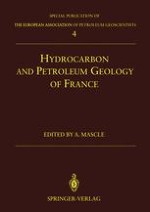1994 | OriginalPaper | Chapter
The Mid-Cretaceous Organic-Rich Sediments from the Vocontian Zone of the French Southeast Basin
Author : J.-G. Bréhéret
Published in: Hydrocarbon and Petroleum Geology of France
Publisher: Springer Berlin Heidelberg
Included in: Professional Book Archive
Activate our intelligent search to find suitable subject content or patents.
Select sections of text to find matching patents with Artificial Intelligence. powered by
Select sections of text to find additional relevant content using AI-assisted search. powered by
During Cretaceous time, the Vocontian basin, which is a part of the French “Bassin Subalpin Méridional”, was characterized by a pelagic sedimentation more or less diluted by fine siliciclastic supplies. In the series, several intervals display organic-rich sediments which are distributed from the Upper Hauterivian to the Lower Turonian.At least, certain organic-rich horizons or intervals appear to constitute local records of widespread oceanographical phenomena. These have been called oceanic anoxic events (OAE) by Schlanger and Jenkyns (1976), and this term has subsequently been used by a number of authors. However, the concept of OAE suffers from a certain vagueness as, for instance, it applies to relatively short-lived episodes (as for the Cenomanian-Turonian event) as well as to periods of more than 20 million years as for Aptian-Albian. More recently, a distinction was made of “subevents” (OASEs) in this last stratigraphical interval (Arthur et al. 1990). The accuracy of this terminology is discussed, thanks to the detailed study of the Aptian-Albian Marnes Bleues Formation.This Marnes Bleues Formation displays a variety of organic-rich sediments. They are recognized as belonging to four types according to their fabric (essentially degree of lamination) and to their organic content (as total organic carbon or TOC), following the example of Bralower and Thierstein (1984). They correspond to class 1 to class 4, from the poorest (< 0.7 % TOC) to the richest ones (usually > 2.5 % and up to 8 % TOC). The arrangement of the organic-rich layers in the series is not at random, but corresponds to an organization into a hierarchy. The study of this organization relies on the identification of sedimentary sequences at different scales.The Marnes Bleues are composed, for the most part, of the stacking of sequences of different orders which are superimposed. A banding is mainly distinguished thanks to a weak contrast in color (from light to dark gray). It presents a very high frequency, and the couplet “dark-light” may be referred to elementary sequences (Ferry 1991). This banding is not always detectable and in several intervals it displays a complex pattern. Most of dark layers belong to class 1 and class 2. Less order sequences are depicted, which very usually group five elementary sequences. These bundles occur very regularly and are particularly well identifiable. Nearly all of them are easily correlated on sections all over the basin. The analogy of these sequences with the genetic sequences described by Cross (1988) and by Guillocheau (1991) in other contexts is strong enough to suggest that they may be another expression of the same kind of sedimentary units generated by fluctuations in relative sea level. In several intervals (as the Lower Albian), these sequences are punctuated by black shales belonging to class 3 and often grouped by two or three. The crushing majority of organic-rich beds occur in such a way, and thus are typically periodites. The frequency (estimated within the limits of the stratigraphical resolution) of these sets of five elementary couplets suggests a possible consequence of variations in Earth’s orbital eccentricity. The close study of the position of organic-rich beds within the genetic sequences allows one to distinguish two types. A first type, “condensed”, occurs more or less in phase with carbonate-rich layers. It is interpreted as formed during lowerings in detrital supply, corresponding to episodes of small rises in relative see level and/or dry climatic phases. A second type, “fed”, is in opposite phase with carbonate-rich layers. It is better explained by small falls in relative sea level and/or wet climatic phases. In any case, these black-shale periodites correspond to a normal recurrent sedimentation which lasts during million years. As a whole, they represent the consequence of long-term trends in global climatic and oceanographic parameters. However, at present, no accurate inter-basinal correlations have been made for individual beds.On the other hand, several horizons are particularly noteworthy firstly because of their high organic content, secondly because they break the regular stacking of the basic sedimentation. They are composed of thin sequences with contrasted facies which record large fluctuations in oceanographical conditions. These beds are rare and aperiodic, and they constitute key beds at the scale of the Vocontian basin. Furthermore, these markers are recognized also in different basins at regional or even at global scale. They may be viewed as records of real events. They come within the framework of low-order sequences (third or second order according to the schemes of Vail et al. 1977). They correspond to the condensation of a whole genetic sequence or even of several, and are the result of episodes of major flooding. Their genesis was only possible because of the propensity for oceanic water to suboxia or anoxia.
